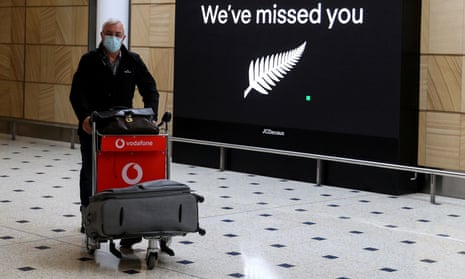The New Zealand government is standing by its plan to establish a trans-Tasman travel “bubble” by April, despite community transmission of coronavirus in several Australian states.
In mid-December the prime minister, Jacinda Ardern, announced that quarantine-free movement between Australia and New Zealand would be instated by the end of March, contingent on no changes in the Covid-19 status of each country. “I think New Zealanders desperately need a break,” she said.
But recent outbreaks of coronavirus in Queensland, New South Wales and Victoria, many of them linked to interstate travel – plus the highly infectious variant of coronavirus driving up cases overseas – had cast doubt on the plan.
Ardern has previously said quarantine-free travel to New Zealand would apply only to places with at least 28 days without transmission of coronavirus in the community. New Zealand has not had community transmission since mid-November.
Covid-19 response minister Chris Hipkins confirmed to the Guardian in a statement on Wednesday that New Zealand was still looking to establish the bubble in the first quarter of 2021. Decisions on a commencement date would “be made early this year, as conditions allow”.
Hipkins said New Zealand officials were closely monitoring the situation in specific parts of Australia, and that both countries would need to meet “a range of health and border requirements … in order for a Trans-Tasman Safe Travel Zone to commence”.
Asked whether quarantine-free travel would be considered with individual Australian states, Hipkins said, separate to the agreed-upon health requirements, “decisions about which states and territories can participate are matters for Australia”.
Australia’s health minister, Greg Hunt, had earlier indicated that the federal government would accept New Zealand’s proposal, describing it as “the first step on a return to international normality”. New Zealanders can already travel to Queensland, NSW and the Northern Territory without having to self-isolate on arrival.
A travel corridor with the Cook Islands and Niue has also been indicated by the end of March.
The vaccine rollout in both countries may also prove relevant to the question of extending the bubble. Australia is starting vaccinating its population from March with view to October completion, while New Zealand has indicated that it will hang back to “take into account the assessments of trusted regulators” overseas.
“The implications of vaccine rollouts for border measures is something that is still being considered and it is too soon to know exactly how these will interact with each other,” said Hipkins. “But both Australia and New Zealand are actively pursuing vaccination purchase and rollout strategies and we are in close contact with each other as these progress.”
But it is considered unlikely that at least the first generation of the vaccine will prevent transmission of coronavirus, with a review commissioned by the Australian Academy of Health and Medical Sciences finding that public health measures and management would remain crucial this year.
Asked what extra precautionary measures would need to be considered or undertaken in New Zealand in order to make a travel bubble with Australia feasible, Hipkins said the two countries were “taking similar approaches to Covid-19, including a very careful approach at the border.
“The health and border requirements for a Trans-Tasman Safe Travel Zone will be strict. As well, officials are completing further readiness work, including contingency planning for an outbreak in either country after a Safe Travel Zone commences.”
Hipkins had earlier been working with Auckland and Wellington airports to create two separate zones for processing those passengers arriving from safe travel destinations, and for those bound for quarantine in a government-managed facility.
Auckland airport’s chief executive, Adrian Littlewood, told Stuff in mid-December that passenger separation facilities and processes were being tested with cooperation of airlines and government agencies, in readiness of the trans-Tasman bubble being approved.
Wellington airport’s general manager of corporate affairs, Jenna Raeburn, said then that the capital’s facilities had already “been ready to roll out safe travel measures … for several months”.
But the government has been so far erring on the side of caution, introducing further border controls in recent weeks. Seven new cases of Covid-19 were identified in managed isolation facilities in New Zealand since Monday.
“We can’t afford to get complacent – especially given the increasing numbers of new cases we’re seeing in many other countries,” said Dr Ashley Bloomfield, the director general of health. “We’ve seen how quickly the virus can spread.”
